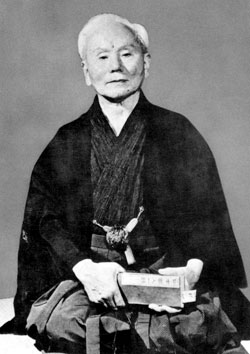

In this class, we practice the Japanese art of Shotokan Karate, a system and art developed over centuries, yet formally organized and spread throughout the world in the early 1900s by renowned Okinawan martial artist Gichin Funakoshi.
Gichin funakoshi 1869-1957The man most responsible for the systemization of Karate as we know it today is Gichin Funakoshi. He was born in Shuri, Okinawa, in 1869, and when only a boy of eleven began to study Karate under two top masters of the art of that time. In time he became a Karate expert in his own right. He is credited with being the first man to introduce Karate to Japan proper, when he gave exhibitions in 1917 and again in 1922 at physical education expositions sponsored by the Ministry of Education. The art soon caught on in Japan, and Funakoshi traveled throughout the country giving lectures and demonstrations. The main universities invited him to help them set up Karate teams, and hundreds of persons studied the art under his guidance.
In 1957, Master Funakoshi, the father of modern Karate, passed away at the advanced age of eighty-eight. But tens of thousands of Karate men who learned under him remain, insuring that the art which he taught will not die with him. On the contrary, persons in many foreign countries have shown great interest in learning Karate, and it is has rapidly become a world art. Mr. Funakoshi changed the meaning of "Chinese Hand", to that of "Empty Hand". He chose the character for its meaning in the Zen Buddhist Philosophy, In rendering oneself empty". He wrote "As a mirror's polished surface reflects whatever stands before it and a quiet valley carries even smaller sounds," so must the student of Karate render his mind empty of selfishness and wickedness in an effort to react appropriately toward anything he might encounter. This is the meaning of "Kara" or empty, of Karate.